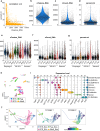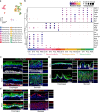Temporal single-cell RNA sequencing dataset of gastroesophagus development from embryonic to post-natal stages
- PMID: 39550363
- PMCID: PMC11569200
- DOI: 10.1038/s41597-024-04081-7
Temporal single-cell RNA sequencing dataset of gastroesophagus development from embryonic to post-natal stages
Abstract
Gastroesophageal disorders and cancers impose a significant global burden. Particularly, the prevalence of esophageal adenocarcinoma (EAC) has increased dramatically in recent years. Barrett's esophagus, a precursor of EAC, features a unique tissue adaptation at the gastroesophageal squamo-columnar junction (GE-SCJ), where the esophagus meets the stomach. Investigating the evolution of GE-SCJ and understanding dysregulation in its homeostasis are crucial for elucidating cancer pathogenesis. Here, we present the technical quality of the comprehensive single-cell RNA sequencing (scRNA-seq) dataset from mice that captures the transcriptional dynamics during the development of the esophagus, stomach and the GE-SCJ at embryonic, neonatal and adult stages. Through integration with external scRNA-seq datasets and validations using organoid and animal models, we demonstrate the dataset's consistency in identified cell types and transcriptional profiles. This dataset will be a valuable resource for studying developmental patterns and associated signaling networks in the tissue microenvironment. By offering insights into cellular programs during homeostasis, it facilitates the identification of changes leading to conditions like metaplasia and cancer, crucial for developing effective intervention strategies.
© 2024. The Author(s).
Conflict of interest statement
Figures





References
-
- Boeckxstaens, G. E. Alterations confined to the gastro-oesophageal junction: the relationship between low LOSP, TLOSRs, hiatus hernia and acid pocket. Best Pract Res Clin Gastroenterol24, 821–829, 10.1016/j.bpg.2010.08.011 (2010). - PubMed
-
- Spechler, S. J. & Souza, R. F. Barrett’s esophagus. N Engl J Med371, 836–845, 10.1056/NEJMra1314704 (2014). - PubMed
Publication types
MeSH terms
Grants and funding
LinkOut - more resources
Full Text Sources

